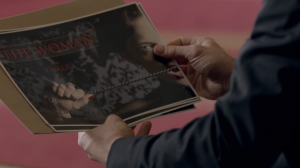http://www.youtube.com/watch?v=mtskKP5TTio
Gillian Horn
Seminar
Friday, October 4, 2013
A particular character in the Sherlock Holmes BBC series that interests me the most is Irene. From the intro of the 2nd season series, she comes across as the rich, pulled together and luxurious female villain. When she initially finds out about Sherlock coming to her house, she starts to get in her “war” zone. Irene is sitting at her vanity putting on red lipstick and make up and talking about her “ war” outfit she is planning to wear. Next she is shown in her bedroom closet in her green lace cover up, staring in her closet. She picks out a sparkly black one shoulder dress and looks at her self in the mirror. At this point Irene is ready to face Sherlock and is prepared for “war”. Soon after this scene, Sherlock shows up to her house and is told to wait in the living room for Irene. She comes out not wearing the dress anymore and is now naked instead. To me this seems like she is trying to lure Sherlock in by her nudity to be distracted and not question what she wants from him. Sherlock tells Irene to put something on but Irene questions it but in the end puts on a coat to cover up. About 5 minutes later of discussion between Irene and Sherlock, men come into her house and hold both of them hostage. Irene is sat down on the couch with a gun against her and Sherlock is brought over to the mural in the living room. Underneath that is a safe which the men see and tell Sherlock to open. Sherlock or Irene do not know the code, but Sherlock manages to open it after the countdown the man holding him was giving before he was going to shoot them. The safe opens and before any of the men can see, a gun being powered by a string starts to shoot at the men. This indicates that Irene must have known that this was going to happen so had decided to put the gun in the safe. This interested me because one moment the two of them arguing and being enemies, but they become partners trying to fight off these men. The characteristic that I would give to Irene after watching these scenes, is a powerful woman. She is powerful because she is clever. The gun in the safe is an example of this power and in a sense you can get from her initial imagery that she is a confident woman who isn’t afraid to fight. She not only is just a woman, but she is also a luxurious and sophisticated woman. The opening scenes help piggy back this statement because it shows her doing things that woman with class and money would do. She is provocative but she is also classy at the same time which makes her unique. A video from youtube, http://www.youtube.com/watch?v=mtskKP5TTio, highlights the moments of Irene Alder from the series and helps show every aspect of her “ powerful woman” personality. The song playing in the background, “ The Ballad of Mona Lisa” by Panic! At The Disco, also helps support the statement of her powerful figure as well. Important lines in the song like, “She paints her fingers with a close precision” and “ Whoa, Mona Lisa, You’re guaranteed to run this town” are important to take note of because Irene puts lipstick on slowly in the begging and although Mona Lisa was married to a King and Irene is not, Irene has the motivation to be powerful like Mona Lisa. From analyzing these scenes, I can fully support the statement that Irene is a powerful woman and displays it throughout the story.









